|
Radiant floor heat is the best type of heat and keeps your
floors toasty warm! radiant floor heat is about 20% more
efficient and you can keep the water temperature much lower;
saving you even more wood or coal!
The water that runs through
your floor for radiant floor heat is never any warmer than 140°.
Hotter temperatures will crack the floor if you have concrete
and may warp your wood if it is any hotter.
One nice thing about
radiant heat, is that it keeps the lower 10 feet of your room
the warmest. This eliminates heat going up to the ceiling and
out the roof where it is ultimately lost. This is one of the
reasons for the great savings with radiant heat. this is
fabulous for rooms that have tall ceilings, such as in great
rooms.
it is also very nice not
having air blowing around. This means that air is not blowing
around either and it ends up feeling warmer.
Hydronic Heat, means
heat distributed via water.
Radiant Heat is heat transferred through space
from a surface without being carried by air or other fluids. It
feels like warmth from the sun. For instance, you are out for a
walk on a cool day, then you are drenched with sudden warmth
from the sun! That's what Radiant Heat
feels like. IT WARMS YOU ALL OVER!
How Hydronic Radiant Floors Work
Here is how Hydronic Radiant Floors work.
Water is circulated through special tubing, called
PEX Tubing, that runs
under the floor. The warn piping radiates heat
through your floor, making it toasty warm.
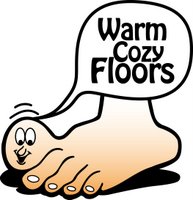
Radiant Floor Heat
is more efficient because it heats you
directly. The room's humidity is also more ideal. It gradually
releases radiant energy to the cool objects in
the room. The warmth is greater at floor level and decreases as
it reaches the ceiling. This is both more comfortable (Your head
feels cooler and your feet are warmer) This type of heating is
not new! It goes back to the Roman Times, and is still a very
popular way to heat in Europe.
Think about installing Radiant Floor Heat
in your new or existing home. The benefits of this superior
heating system include, even warmth, higher efficiency, quieter,
cleaner, cozier and healthier heating!
if you have an existing home, you may be able
to put radiators in their; either the old-style cast-iron
radiators, baseboard Hydronic heaters ( they look just like
electric baseboard heaters except they carry water and are
extremely more efficient), newer style radiators that looked
much better but then again if you have an older house then the
old-style cast-iron radiators may look very good - and are
usually very cheap if they are but used!
a new construction we usually recommend
that you put Pex pipe in your flooring. This can either be on
the sub-floor or underneath the sub-floor, with the finished
material on top - be it ceramic for porcelain tile, carpet or
Hardwood.
PEX Tubing
the most common pipes used today are leak
resistant, non-toxic, high-temperature, flexible piping called
cross-linked polyethylene or PEX as it is known
in the industry. Popular due to the fact that it can handle both
aggressive concrete additives and also water conditions while
not becoming brittle over time, PEX tubing has been used in
Europe since the 1970s and in the US since the 1980s. PEX tubing
has proven to be much more reliable.
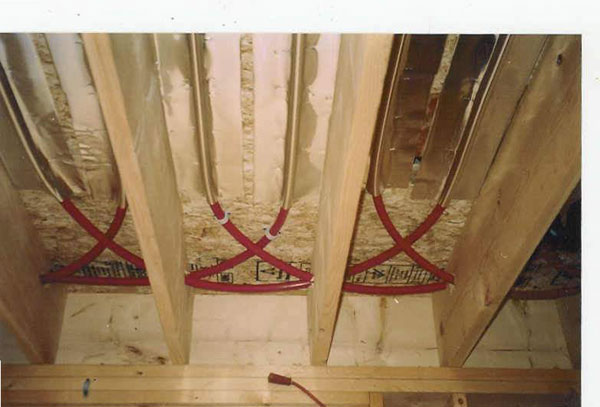
This is what is called a double run. This
gives you more heat between the joists and better heat
distribution than a single run of pipe.

The metal plates are nailed to the subfloor
and hold the Pex pipe in place.
The metal plates transfer the heat across the floor so that you
don't have hot and cold strips. However, this way you have to
heat up the subfloor first before the heat can be transferred to
the flooring.
A better way - in new construction - is just
the piping on top of the subfloor. This way you are heating the
finished flooring instead of all the wood in the subfloor.
This is accomplished by putting floaters on
the floor, as spacers for the Pex pipe.
An even better way is to use a pre-made
product that has grooves cut it to accommodate the Pex pipe and
it already has the aluminum on it (and in the grroves) to spread
the heat over the floor. The best product that I have found is
called
Warmboard. Warmboard is a structural radiant panel that is
1-1/8” thick, made of Douglas Fir 7 ply plywood, and is sold in
full-faced tongue and groove
4’ x 8’ sheets.
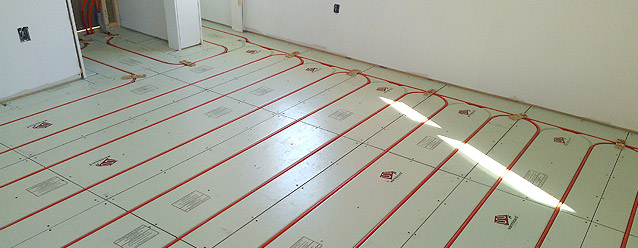
This is what constitutes your subfloor. Once
you put it down over your floor joists or truss, your floor is
done! this saves a lot of extra work. Simply put the Pex pipe in
the grooves and put your flooring over it. You will end up with
a VERY solid floor.
It is not the cheapest on the market but it
certainly is the best!
SLAB Radiant Heat can be a DIY project.
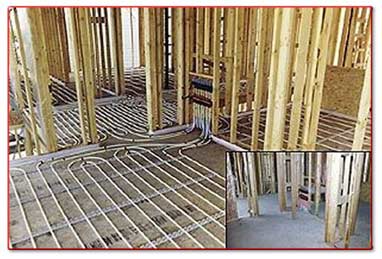
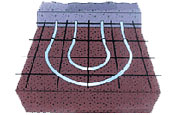
You start with a bed of gravel and then put
insulation down. This is a must so that you are heating the
ground. Is usually required under most building codes, as well.
I prefer a product called TheBarrier. It is
better then the hard foam panels - pink or blue - because it is
extremely flexible and will not crack or break up when you walk
on it. Remember, you have to walk on it to put the wire down and
tie the Pex pipe to it and then the workers will be pouring
concrete and walking all over it.

TheBarrier
insulation is a flexible type that comes in a roll and it has
its adhesive strips to attach it to the piece next to it. This
is designed so that it forms both a vapor barrier and a radon
barrier in one simple step. If you use the big sheets of
Styrofoam, you would then have to go back and put plastic over
it the form the barrier needed.
Most people put 6" x 6" wire down, that comes
in a roll. You will then use wire ties to loosely attached the
Pex pipe to the wire. This stops the Pex pipe from floating to
the surface and ruining your nice new floor.
Some people use rebar instead of the wire
which you'll give you an even stronger floor. Sometimes the
rebar is supported so that it isn't sitting on the bottom.

This is an upstairs floor - not a basement slab. That is why the
concrete is so thin, because it is extremely heavy. A typical
basement slab is 4 inches thick.
Pex pipe, pre-insulated Pex pipe,
manifolds and pumps, plate or water-to-water heat exchanger and
water-to-air heat exchangers.
Please call Ted at Abbott Boiler Supply for al
of you radiant heating, Hydronic heat needs including SharkBite™
stile fittings, Pex pipe, pre-insulated Pex pipe, manifolds and
pumps, etc., plus he has the needed plate or water-to-water heat
exchanger and water-to-air heat exchangers.
828-687-4074
You can Ted at
or reach us by e-mail at
Abbott Boiler Supply and
Shaver Furnace gladly accepts accept VISA, MasterCard, Discover
and AMEX as well as PayPal.








DEALER ENQUIRIES WELCOME!
SHAVER
OUTDOOR WOOD FURNACE
Get a Superior Wood Furnace
Since
1972 - Get
a Hyprotherm Wood Boiler!
|